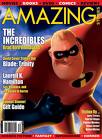
Amazing Stories
The Magazine
Though it has been speculated that the idea for "Amazing Stories" had been germinating in Gernsback's mind for at least two years, the actual creation of the magazine seemed rather abrupt. By merging "The Experimenter" with "Science and Invention," Gernsback was able to devote the former's printing time, editorial time, and distribution to the new magazine.
Gernsback chose Dr. T. O'Conor Sloane for his associate or managing editor; the position primarily entailed assembling the issue and preparing it for press. C.A. Brandt and Wilbur C. Whitehead acted as literary editors, but Brandt was probably responsible for most of the initial selections. Gernsback himself acted as editor, and maintained control over all content. Frank R. Paul was selected as the cover artist and primary illustrator. His use of red and yellow were extremely effective in capturing public attention and enhanced the instant success of the magazine.
The first issue of "Amazing Stories" hit newsstands on March 5, 1926, and was dated April 2006. It was larger than the standard pulp magazine, measuring 8 by 11 inches, and it was thicker too, printed upon paper eventually named "Amazing Stories Bulky Weave." The cost, 25 cents, was also more than the average pulp magazine, which cost 10 or 15 cents. All these things were intended to set "Amazing Stories" apart. The strategy was successful, as the original print run, probably 100,000 copies, sold out.
The entirety of the first and second issues, and large portions of each issue for the first year, were reprints from Hugo's previous magazines. This was partially to keep costs down because he already owned rights to the work, and partially, as Hugo claimed, because there was little quality work to choose from. This second claim, interesting because of the numerous Science Fiction authors producing at the time, may have been because Gernsback and his editors, all more scientific than literary, created a magazine emphasizing science surrounded by story, which may have driven more literary authors to adventure pulps.
The first issue featured "Off on a Comet" (Part 1) by Jules Verne, "The New Accelerator" by H.G. Wells, "The Man From the Atom" (Part 1) by G. Peyton Wertenbaker, "The Thing From--Outside" by George Allan England, "The Man Who Saved Earth" by Austin Hall and "The Facts in the Case of M. Valdemar" by Edgar Allan Poe. All but Wertenbaker were well-established authors guaranteed to attract large audiences, but each also adhered to Gernsback's ideas about Science Fiction.
Hugo's cheap ways, and habit of paying authors long after publication, soon alienated established writers such as A. Hyatt Verrill. Burroughs, H.P. Lovecraft, and soon drove away any talented newcomers with his exploitation. However, the Great Depression or the daytime jobs of many authors kept contributions flowing. A. Hyatt Verrill, Miles J. Breur, Clare Winger Harris, Edmond Hamilton, and David H. Keller were among the earliest regular contributors to the magazine. By 1929, Gernsback had established a large pool of authors, including Charles Cloukey, Francis Flagg, Philip Francis Nolan, and Alexander M. Phillips.
While publishing amazing, Gernsback continued to expand in radio and television, using the proceeds from his successful magazines for funding. As he poured money into these enterprises, Gernsback neglected his other bills and in February 1929 The Art Color Printing Company and Bulky, Dunton & Company filed suit against The Experimenter Publishing Company. The company was temporarily run by the Irving Trust Company, which managed to save the publications and eventually sold to B.A. MacKinnon.
Never one to be bowed by failure, within a year Gernsback launched three new Science Fiction magazines: "Science Wonder Stories," "Air Wonder Stories," and "Science Wonder Quarterly."
After Gernsback
The new publishers of "Amazing Stories" appointed T. O'Conor Sloane as editor, a position he maintained until 1938, when the magazine was sold to Ziff Davis. The new editor, Raymond A. Palmer, printed the magazine in the traditional pulp format. He was also the editor of a companion magazine, "Fantastic Adventures," which was more fantasy oriented. This magazine experienced a name change, to "Fantastic" in 1954, and eventually merged with and took the name "Amazing Stories" in 1980 under editor Howard Browne.
Amazing continued publication more or less continuously from 1926 until the 1990s under various editors, publishers and formats. During the final ten years it was published erratically, and eventually Wizards of the Coast cancelled the version published by Pierce Watters.
In 2004 it was relaunched by Paizo Publishing, but after the April 2005 issue, the magazine was put on hold. In March 2006, Paizo announced that it would no longer publish "Amazing Stories."
Editors

* Hugo Gernsback (April 1926-April 1929)
* Arthur Lynch (May 1929-October 1929)
* T. O'Conor Sloane (November 1929-May 1939)
* Raymond A. Palmer (June 1939-December 1939)
* Bernard G. Davis (January 1940-May 1946)
* Raymond A. Palmer (June 1946-December 1949)
* Howard Browne (January 1950-August 1956)
* Paul W. Fairman (September 1956-December 1958)
* Cele Goldsmith Lalli (January 1959-June 1965)
* Joseph Wrzos (August 1965-October 1967)
* Harry Harrison (December 1967-September 1968)
* Barry N. Malzberg (November 1968-January 1969)
* Ted White (March 1969-February 1979)
* Elinor Mavor (May 1979-August 1981 under the pseudonym Omar Gohagen, November 1981-September 1982 under her own name)
* George H. Scithers (November 1982-July 1986)
* Patrick Lucien Price (September 1986-March1991)
* Kim Mohan (May 1991-1995 and 1998-2000)
* David Gross (May 2004-October 2004)
* Jeff Berkwits (October 2004-March 2005)
